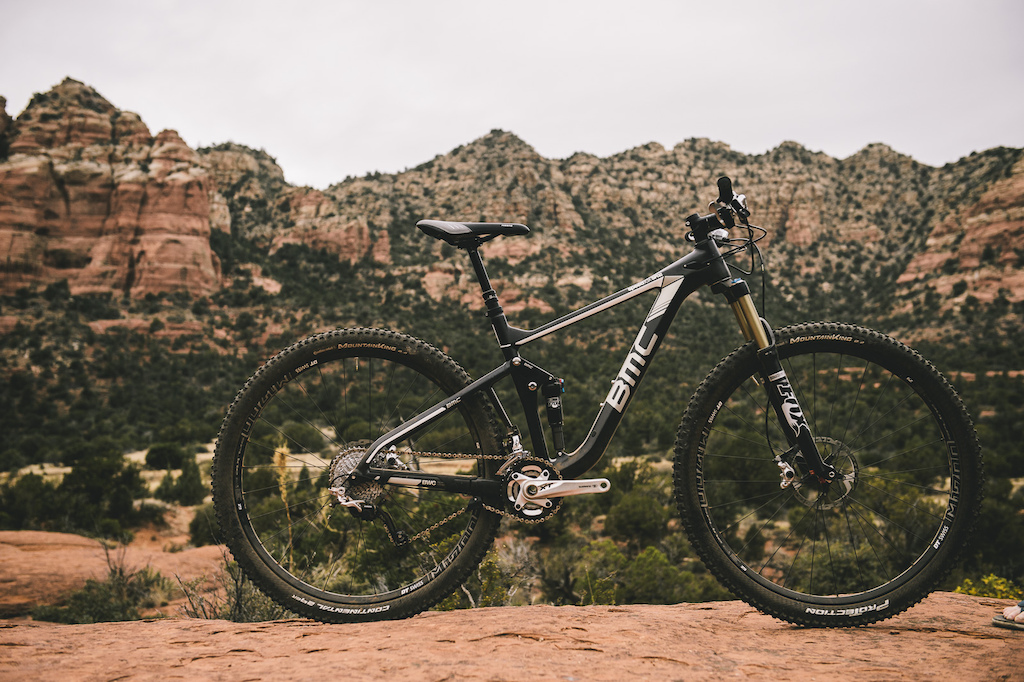BMC Speedfox SF02 XT - Review
BMC hails from Switzerland, a place where everyone seems to approach life in a slightly different way than the rest of the world. Somehow, the Swiss have blended timeliness and order with some of the most wild and spectacular landscapes to be found on the European subcontinent. This is a modern society, tucked between mountains and massive vertical cliffs carved during the Ice Age, where church bells ring out the work day, dairy cattle browse at ski resorts and beside Lego-colored manufacturing plants, which in turn are flanked by vegetable and flower farms. Cityscapes are punctuated by densely forested hills and flowers hang from the windows of multi-story metal and glass buildings. Viewed from above, much of Switzerland appears to be a manicured toy train set that has somehow sprung to life. Having spent time there, I would expect BMC's mountain bikes to look and ride differently than their counterparts in mainstream cycling, and they do, as witnessed by this week's test bike: the 130-millimeter-travel Speed Fox SF02 29er.
Speedfox SF02 XT Details:
• Purpose: Technical trail riding
• Construction: Carbon front section, aluminum dual-link rear suspension, internal cables
• Wheel Size: 29-inch
• Rear wheel travel: 130mm
• Fork: Fox 32 Float Evolution CTD, 130mm stroke
• Shock: Fox Float CTD
• Drivetrain: Shimano XT, 2 x 10
• Brakes: Shimano XT, 180mm rotors
• Wheels: DT Swiss Spline M1700
• Weight: 28.75 pounds. (13.07kg, medium size)
• MSRP $4999 USD
• Contact: BMC @ridebmc
Meet the Speedfox
Before we get started, BMC offers the SF02 in three builds: one based upon a SRAM X0 two-by-ten drivetrain; our test model, which features a Shimano XT two-by-ten transmission; and a more affordable version based upon a Shimano SL/XT ensemble. All three use the same chassis and many of the components are duplicated between the builds. The MSRP of our mid-priced BMC Speedfox SF02 XT is $4999 USD and our medium-sized test bike weighed in at 28.75 pounds (13.07kg).
Overview: Europe was a little late on the 29-inch wheel thing, but BMC was one of the early adopters, so the Speedfox SF02 enjoys second-generation trail bike geometry and an intelligent component spec that includes low, big-wheel-specific gearing; tires with aggressive dirt-worthy tread, and a Stealth Reverb dropper post. The heart of the Speedfox is a sturdy chassis, constructed with a carbon fiber front section, mated to an aluminum dual-link rear suspension.
While its corners may be rounded off, the Speedfox's profile is angular and airy, with a rocker-driven Fox CTD shock that is positioned vertically to make room for a down tube water bottle. The frame's faceted and rectangular-profiled tubes are abruptly tapered and angled in sharp contrast to the present curvy and organic school of trailbike design, but it works. BMC's Speedfox looks modern and capable.
Details: Molded, screw-on plastic caps make for clean entries and exits for the Speed Fox's internal housing and hoses, and a thick, molded rubber chainstay protector ensures that the BMC will stay quiet on the downs. BMC tucked the post-mount rear brake caliper behind the seat stay for protection and the mount is dedicated to 180-millimeter rotors. Below the right-side chainstay is a simple pass-through chain guide, similar to the one which Specialized fits to its mid-travel trail bikes. As mentioned, the SF02 has an internally routed RockShox Reverb Stealth dropper post, which further cleans up the bike's already sharp appearance.
Sizing: BMC offers the Speedfox in five sizes, from X-small through X-large, and its dramatically sloped top tube should assist most riders to fit over the bike's 29-inch wheels, in spite of its 130-millimeter-travel rear suspension. Curiously, BMC lists every conceivable frame dimension on its geometry chart except the stand-over clearance for each size they offer. Our medium-sized model measured 29 inches (480mm) from ground level, to the top tube at the nose of the saddle, which suggests that the small and X-small frames may be on the tall side for diminutive riders.
Suspension: BMC calls it their "Advanced Pivot System," which is yet another fancy term for the dual-link, four-bar rear suspension which has become the fallback design for most of the industry. BMC's version drives a Fox Float CTD shock to produce 130 millimeters of rear travel. Short linkages cause rapidly changing leverage rates, which virtually guarantees that no two dual-link designs will perform exactly the same. BMC claims the middle path: a suspension that pedals well, brakes well and still manages to provide a smooth, controllable ride. Ambitious, perhaps, but not an impossible goal. Up front, the Speedfox relies on a 130-millimeter stroke Fox CTD Evolution fork, with 32-millimeter stanchions. Most trail bikes we were testing at the time had forks with stouter stanchions, so we were keenly interested in how well the BMC would hang with the burlier bikes at speed.







